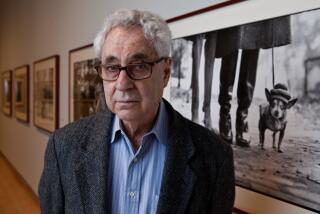A photographer is rescued from history’s shadow
- Share via
PITTSBURGH — For decades, Luke Swank was lost to the world of photography. His elegant black-and-white images of workers, circus performers and steel mills had been exhibited alongside the work of acknowledged masters but virtually disappeared from public view after his death in the 1940s.
Now a new book and museum retrospective seek to return the photographer to prominence.
Details about Swank’s life are vague, but thousands of photographs he took between the 1920s and 1940s reveal an artist at the forefront of the Modernist movement, shifting from the soft-focus techniques of earlier pictorialists to a sharp documentary style.
Pictures of face-painted clowns, abandoned storefronts and the shadowy interiors of historic buildings show aspects of American life that were waning by the time Swank captured them on film, said Howard Bossen, a journalism professor at Michigan State University.
“They’re cinematic moments, really showing us the times,” said Bossen, who guest-curated the exhibition “Luke Swank: Modernist Photographer” at Pittsburgh’s Carnegie Museum of Art and wrote a book of the same title.
“He’s not concerned with place,” added Bossen. “He’s concerned with visual poetry.”
Swank’s talents lay in his darkroom expertise and “incredible understanding of light,” which plays off hat brims, streams of molten steel and staircases in some of the exhibition’s 141 photographs. He methodically turned ordinary objects such as woven baskets and rolls of tape into striking abstract images.
When turning his camera toward people, the photographer showed a remarkable sensitivity for his working-class subjects, Bossen added.
Even in an era when photography was not yet fully recognized as a fine art, Swank’s work won praise. Architect Frank Lloyd Wright admired Swank’s images and hired him to photograph his buildings. “He was part of the scene,” said Bossen.
Born in 1890 to a wealthy mercantile family, Swank dabbled in several professions, including vegetable farming and dog training, before serving in the Army at a poison gas research facility during World War I.
He later settled with his wife and son in his hometown of Johnstown, Pa., where he managed his family’s hardware store and eventually ran their car dealership.
It’s unclear exactly when Swank took up photography, but it’s believed he began when he was nearly 40. Within a few years, he had entered his work in competitive salons and had it displayed at New York’s Museum of Modern Art.
Swank’s gritty images of a steel foundry in Bethlehem, Pa., graced gallery walls along with works by now-renowned photographers such as Margaret Bourke-White, Walker Evans, Edward Steichen and Charles Sheeler.
A 1934 review in Vanity Fair magazine said: “Not only is Swank interested in interpreting American life, but in revealing what is peculiar to American light and air. Therein, we believe, lies his artistry.”
With his family’s fortunes depleted by the Depression, Swank moved to Pittsburgh, where he became the University of Pittsburgh’s official photographer and taught a noted course. He left two years later to open his own studio, financed by the local department store magnate Edgar Kaufmann, his friend of many years.
He undertook commercial assignments and shot urban and industrial scenes, some of which were published on the pages of Fortune magazine, before he died of a heart attack in 1944 at age 54.
Despite having achieved considerable recognition, Swank’s work quickly faded into obscurity. His wife, Edith, stored many of his photographs in boxes for decades before bequeathing them to the Carnegie Library in Pittsburgh in 1975.
Swank’s sudden disappearance from the photography mainstream may have been a result of the fact that his work was not as widely published as that of contemporaries such as Bourke-White, who was a staff photographer for popular magazines. Also, Swank did not write for publication, like better-known photographers of the time.
Bossen began to research Swank and his work four years ago, compiling prints for the exhibition and book, an experience he described as “a huge task, a wonderful task.”
“I had to find an enormous amount of documents and start to reconstruct his personal life and his artistic life,” he said. “It helps build the case for him as a photographer.”
The Swank exhibition closes Feb. 5 and will not be traveling, but the book that accompanies the exhibition is being sold nationwide.
More to Read
The biggest entertainment stories
Get our big stories about Hollywood, film, television, music, arts, culture and more right in your inbox as soon as they publish.
You may occasionally receive promotional content from the Los Angeles Times.










